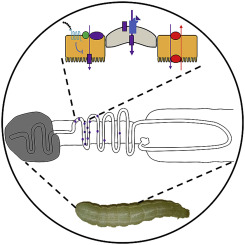当前位置:
X-MOL 学术
›
Insect Biochem. Mol. Biol.
›
论文详情
Our official English website, www.x-mol.net, welcomes your
feedback! (Note: you will need to create a separate account there.)
Mechanisms and regulation of chloride transport in the Malpighian tubules of the larval cabbage looper Trichoplusia ni.
Insect Biochemistry and Molecular Biology ( IF 3.2 ) Pub Date : 2019-11-02 , DOI: 10.1016/j.ibmb.2019.103263 Dennis Kolosov 1 , Michael J O'Donnell 1
Insect Biochemistry and Molecular Biology ( IF 3.2 ) Pub Date : 2019-11-02 , DOI: 10.1016/j.ibmb.2019.103263 Dennis Kolosov 1 , Michael J O'Donnell 1
Affiliation

|
Malpighian tubules (MTs) and the hindgut together constitute the excretory system of insects. Larvae of lepidopterans (butterflies and moths) demonstrate the so-called cryptonephric arrangement, where the distal blind end of each MT is embedded into the rectal complex. The rest of the free tubule is modified into several distinct regions that differ greatly in the transport of cations and water. However, relatively little is known about the transport of counter-anions (e.g., Cl- and HCO3-) by the MTs of lepidopteran larvae. In the current study we used ion-selective microelectrodes to characterize Cl- transport in the distinct regions of the free MT of the larval Trichoplusia ni. Firstly, we note that Cl- transport in the MTs is sensitive to the Cl- concentration of the bathing saline, and several regions of the MTs are capable of either secreting or reabsorbing Cl-. In the distal ileac plexus (DIP), a region previously characterized by cellular heterogeneity and its ability to switch between cation secretion and reabsorption, principal cells (PCs) toggled between Cl- reabsorption (in high-Cl- saline) and Cl- secretion (in low-Cl- saline). In contrast, secondary cells (SCs) in the DIP secreted Cl- regardless of saline Cl- concentration. Mechanistically, we have detected a number of 'leak' and ligand-gated Cl- channels (ClC) and demonstrated that Cl- channels are involved in Cl- secretion. Additionally, we demonstrated that the lumen-positive transepithelial potential increased in response to glycine. Using the scanning ion-selective electrode technique we demonstrated that glycine stimulated Cl- secretion by SCs, but not by PCs. In contrast, when MTs were deprived of glycine, a decrease in Cl- secretion, coupled with a decrease in the TEP, was observed. In contrast to the effects of glycine, an active dose of helicokinin reduced Cl- secretion by PCs, but not by SCs. Lastly, we detected expression of chloride-bicarbonate exchangers (CBE) in all regions of the free tubule. Scans of H+ transport across the tubule indicated that base equivalents are likely reabsorbed across the ileac plexus. Blocking ClC or CBE led to secretion of a more basic fluid, indicating lack of base reabsorption. We suggest that the transport of Cl- in the MTs of larval lepidopterans (i) may be correlated with the reabsorption of base, (ii) may be sensitive to Cl- concentration in the haemolymph, and (iii) could be regulated by helicokinin and glycine.
中文翻译:

幼虫白菜弯管虫Trichoplusia ni的Malpighian小管中氯化物运输的机制和调控。
Malpighian小管(MTs)和后肠共同构成昆虫的排泄系统。鳞翅目的幼虫(蝴蝶和飞蛾)表现出所谓的隐肾排列,其中每个MT的远端盲端都嵌入直肠复合体中。其余的游离小管被修饰成几个不同的区域,这些区域在阳离子和水的传输方面有很大的不同。然而,关于鳞翅目幼虫MTs的抗衡阴离子(例如Cl-和HCO3-)的运输知之甚少。在当前的研究中,我们使用离子选择性微电极来表征幼虫毛癣菌游离MT的不同区域的Cl转运。首先,我们注意到MT中的Cl-转运对沐浴盐水的Cl-浓度敏感,MT的几个区域能够分泌或吸收Cl-。在回肠远端神经丛(DIP)中,该区域先前以细胞异质性为特征,并且具有在阳离子分泌和重吸收之间切换的能力,主要细胞(PC)在Cl-重吸收(在高Cl-盐水中)和Cl-分泌之间切换(在低氯盐溶液中)。相反,DIP中的二次细胞(SCs)分泌Cl-,而与盐水中的Cl-浓度无关。从机制上讲,我们已经检测到许多“泄漏”和配体门控的Cl-通道(ClC),并证明了Cl-通道与Cl-分泌有关。此外,我们证明了对甘氨酸的反应,管腔阳性的跨上皮电位增加。使用扫描离子选择电极技术,我们证明了甘氨酸刺激了SC的Cl分泌,但不是通过PC。相反,当MTs缺少甘氨酸时,观察到Cl分泌减少,而TEP减少。与甘氨酸的作用相反,有效剂量的螺旋素减少了PCs而不是SCs的Cl分泌。最后,我们检测到游离小管的所有区域中的氯化物-碳酸氢盐交换剂(CBE)的表达。跨小管的H +转运扫描表明,碱当量很可能在回肠神经丛中被重新吸收。阻断ClC或CBE导致分泌更多碱性液体,表明缺乏碱重吸收。我们建议在幼虫鳞翅目动物的MT中运输Cl-(i)可能与碱的重吸收有关;(ii)可能对血淋巴中的Cl-浓度敏感;并且(iii)可能由螺旋素和甘氨酸。当MT被剥夺甘氨酸时,观察到Cl分泌减少,而TEP减少。与甘氨酸的作用相反,有效剂量的螺旋素减少了PCs而不是SCs的Cl分泌。最后,我们检测到游离小管的所有区域中的氯化物-碳酸氢盐交换剂(CBE)的表达。跨小管的H +转运扫描表明,碱当量很可能在回肠神经丛中被重新吸收。阻断ClC或CBE导致分泌更多碱性液体,表明缺乏碱重吸收。我们建议在幼虫鳞翅目动物的MT中运输Cl-(i)可能与碱的重吸收有关;(ii)可能对血淋巴中的Cl-浓度敏感;并且(iii)可能由螺旋素和甘氨酸。当MT被剥夺甘氨酸时,观察到Cl分泌减少,而TEP减少。与甘氨酸的作用相反,有效剂量的螺旋素减少了PCs而不是SCs的Cl分泌。最后,我们检测到游离小管的所有区域中的氯化物-碳酸氢盐交换剂(CBE)的表达。跨小管的H +转运扫描表明,碱当量很可能在回肠神经丛中被重新吸收。阻断ClC或CBE导致分泌更多碱性液体,表明缺乏碱重吸收。我们建议在幼虫鳞翅目动物的MT中运输Cl-(i)可能与碱的重吸收有关;(ii)可能对血淋巴中的Cl-浓度敏感;并且(iii)可能由螺旋素和甘氨酸。观察到TEP降低。与甘氨酸的作用相反,有效剂量的螺旋素减少了PCs而不是SCs的Cl分泌。最后,我们检测到游离小管的所有区域中的氯化物-碳酸氢盐交换剂(CBE)的表达。跨小管的H +转运扫描表明,碱当量很可能在回肠神经丛中被重新吸收。阻断ClC或CBE导致分泌更多碱性液体,表明缺乏碱重吸收。我们建议在幼虫鳞翅目动物的MT中运输Cl-(i)可能与碱的重吸收有关;(ii)可能对血淋巴中的Cl-浓度敏感;并且(iii)可能由螺旋素和甘氨酸。观察到TEP降低。与甘氨酸的作用相反,有效剂量的螺旋素减少了PCs而不是SCs的Cl分泌。最后,我们检测到游离小管的所有区域中的氯化物-碳酸氢盐交换剂(CBE)的表达。跨小管的H +转运扫描表明,碱当量很可能在回肠神经丛中被重新吸收。阻断ClC或CBE导致分泌更多碱性液体,表明缺乏碱重吸收。我们建议在幼虫鳞翅目动物的MT中运输Cl-(i)可能与碱的重吸收有关;(ii)可能对血淋巴中的Cl-浓度敏感;并且(iii)可能由螺旋素和甘氨酸。活性剂量的激肽可以降低PC的Cl分泌,但不能降低SC的Cl分泌。最后,我们检测到游离小管的所有区域中的氯化物-碳酸氢盐交换剂(CBE)的表达。跨小管的H +转运扫描表明,碱当量很可能在回肠神经丛中被重新吸收。阻断ClC或CBE导致分泌更多碱性液体,表明缺乏碱重吸收。我们建议在幼虫鳞翅目动物的MT中运输Cl-(i)可能与碱的重吸收有关;(ii)可能对血淋巴中的Cl-浓度敏感;并且(iii)可能由螺旋素和甘氨酸。活性剂量的激肽可以降低PC的Cl分泌,但不能降低SC的Cl分泌。最后,我们检测到游离小管的所有区域中的氯化物-碳酸氢盐交换剂(CBE)的表达。跨小管的H +转运扫描表明,碱当量很可能在回肠神经丛中被重新吸收。阻断ClC或CBE导致分泌更多碱性液体,表明缺乏碱重吸收。我们建议在幼虫鳞翅目动物的MT中Cl-的运输(i)可能与碱的重吸收有关;(ii)可能对血淋巴中的Cl-浓度敏感;并且(iii)可能由螺旋素和甘氨酸。跨小管的H +转运扫描表明,碱当量很可能在回肠神经丛中被重新吸收。阻断ClC或CBE导致分泌更多碱性液体,表明缺乏碱重吸收。我们建议在幼虫鳞翅目动物的MT中运输Cl-(i)可能与碱的重吸收有关;(ii)可能对血淋巴中的Cl-浓度敏感;并且(iii)可能由螺旋素和甘氨酸。跨小管的H +转运扫描表明,碱当量很可能在回肠神经丛中被重新吸收。阻断ClC或CBE导致分泌更多碱性液体,表明缺乏碱重吸收。我们建议在幼虫鳞翅目动物的MT中运输Cl-(i)可能与碱的重吸收有关;(ii)可能对血淋巴中的Cl-浓度敏感;并且(iii)可能由螺旋素和甘氨酸。
更新日期:2019-11-02
中文翻译:

幼虫白菜弯管虫Trichoplusia ni的Malpighian小管中氯化物运输的机制和调控。
Malpighian小管(MTs)和后肠共同构成昆虫的排泄系统。鳞翅目的幼虫(蝴蝶和飞蛾)表现出所谓的隐肾排列,其中每个MT的远端盲端都嵌入直肠复合体中。其余的游离小管被修饰成几个不同的区域,这些区域在阳离子和水的传输方面有很大的不同。然而,关于鳞翅目幼虫MTs的抗衡阴离子(例如Cl-和HCO3-)的运输知之甚少。在当前的研究中,我们使用离子选择性微电极来表征幼虫毛癣菌游离MT的不同区域的Cl转运。首先,我们注意到MT中的Cl-转运对沐浴盐水的Cl-浓度敏感,MT的几个区域能够分泌或吸收Cl-。在回肠远端神经丛(DIP)中,该区域先前以细胞异质性为特征,并且具有在阳离子分泌和重吸收之间切换的能力,主要细胞(PC)在Cl-重吸收(在高Cl-盐水中)和Cl-分泌之间切换(在低氯盐溶液中)。相反,DIP中的二次细胞(SCs)分泌Cl-,而与盐水中的Cl-浓度无关。从机制上讲,我们已经检测到许多“泄漏”和配体门控的Cl-通道(ClC),并证明了Cl-通道与Cl-分泌有关。此外,我们证明了对甘氨酸的反应,管腔阳性的跨上皮电位增加。使用扫描离子选择电极技术,我们证明了甘氨酸刺激了SC的Cl分泌,但不是通过PC。相反,当MTs缺少甘氨酸时,观察到Cl分泌减少,而TEP减少。与甘氨酸的作用相反,有效剂量的螺旋素减少了PCs而不是SCs的Cl分泌。最后,我们检测到游离小管的所有区域中的氯化物-碳酸氢盐交换剂(CBE)的表达。跨小管的H +转运扫描表明,碱当量很可能在回肠神经丛中被重新吸收。阻断ClC或CBE导致分泌更多碱性液体,表明缺乏碱重吸收。我们建议在幼虫鳞翅目动物的MT中运输Cl-(i)可能与碱的重吸收有关;(ii)可能对血淋巴中的Cl-浓度敏感;并且(iii)可能由螺旋素和甘氨酸。当MT被剥夺甘氨酸时,观察到Cl分泌减少,而TEP减少。与甘氨酸的作用相反,有效剂量的螺旋素减少了PCs而不是SCs的Cl分泌。最后,我们检测到游离小管的所有区域中的氯化物-碳酸氢盐交换剂(CBE)的表达。跨小管的H +转运扫描表明,碱当量很可能在回肠神经丛中被重新吸收。阻断ClC或CBE导致分泌更多碱性液体,表明缺乏碱重吸收。我们建议在幼虫鳞翅目动物的MT中运输Cl-(i)可能与碱的重吸收有关;(ii)可能对血淋巴中的Cl-浓度敏感;并且(iii)可能由螺旋素和甘氨酸。当MT被剥夺甘氨酸时,观察到Cl分泌减少,而TEP减少。与甘氨酸的作用相反,有效剂量的螺旋素减少了PCs而不是SCs的Cl分泌。最后,我们检测到游离小管的所有区域中的氯化物-碳酸氢盐交换剂(CBE)的表达。跨小管的H +转运扫描表明,碱当量很可能在回肠神经丛中被重新吸收。阻断ClC或CBE导致分泌更多碱性液体,表明缺乏碱重吸收。我们建议在幼虫鳞翅目动物的MT中运输Cl-(i)可能与碱的重吸收有关;(ii)可能对血淋巴中的Cl-浓度敏感;并且(iii)可能由螺旋素和甘氨酸。观察到TEP降低。与甘氨酸的作用相反,有效剂量的螺旋素减少了PCs而不是SCs的Cl分泌。最后,我们检测到游离小管的所有区域中的氯化物-碳酸氢盐交换剂(CBE)的表达。跨小管的H +转运扫描表明,碱当量很可能在回肠神经丛中被重新吸收。阻断ClC或CBE导致分泌更多碱性液体,表明缺乏碱重吸收。我们建议在幼虫鳞翅目动物的MT中运输Cl-(i)可能与碱的重吸收有关;(ii)可能对血淋巴中的Cl-浓度敏感;并且(iii)可能由螺旋素和甘氨酸。观察到TEP降低。与甘氨酸的作用相反,有效剂量的螺旋素减少了PCs而不是SCs的Cl分泌。最后,我们检测到游离小管的所有区域中的氯化物-碳酸氢盐交换剂(CBE)的表达。跨小管的H +转运扫描表明,碱当量很可能在回肠神经丛中被重新吸收。阻断ClC或CBE导致分泌更多碱性液体,表明缺乏碱重吸收。我们建议在幼虫鳞翅目动物的MT中运输Cl-(i)可能与碱的重吸收有关;(ii)可能对血淋巴中的Cl-浓度敏感;并且(iii)可能由螺旋素和甘氨酸。活性剂量的激肽可以降低PC的Cl分泌,但不能降低SC的Cl分泌。最后,我们检测到游离小管的所有区域中的氯化物-碳酸氢盐交换剂(CBE)的表达。跨小管的H +转运扫描表明,碱当量很可能在回肠神经丛中被重新吸收。阻断ClC或CBE导致分泌更多碱性液体,表明缺乏碱重吸收。我们建议在幼虫鳞翅目动物的MT中运输Cl-(i)可能与碱的重吸收有关;(ii)可能对血淋巴中的Cl-浓度敏感;并且(iii)可能由螺旋素和甘氨酸。活性剂量的激肽可以降低PC的Cl分泌,但不能降低SC的Cl分泌。最后,我们检测到游离小管的所有区域中的氯化物-碳酸氢盐交换剂(CBE)的表达。跨小管的H +转运扫描表明,碱当量很可能在回肠神经丛中被重新吸收。阻断ClC或CBE导致分泌更多碱性液体,表明缺乏碱重吸收。我们建议在幼虫鳞翅目动物的MT中Cl-的运输(i)可能与碱的重吸收有关;(ii)可能对血淋巴中的Cl-浓度敏感;并且(iii)可能由螺旋素和甘氨酸。跨小管的H +转运扫描表明,碱当量很可能在回肠神经丛中被重新吸收。阻断ClC或CBE导致分泌更多碱性液体,表明缺乏碱重吸收。我们建议在幼虫鳞翅目动物的MT中运输Cl-(i)可能与碱的重吸收有关;(ii)可能对血淋巴中的Cl-浓度敏感;并且(iii)可能由螺旋素和甘氨酸。跨小管的H +转运扫描表明,碱当量很可能在回肠神经丛中被重新吸收。阻断ClC或CBE导致分泌更多碱性液体,表明缺乏碱重吸收。我们建议在幼虫鳞翅目动物的MT中运输Cl-(i)可能与碱的重吸收有关;(ii)可能对血淋巴中的Cl-浓度敏感;并且(iii)可能由螺旋素和甘氨酸。











































 京公网安备 11010802027423号
京公网安备 11010802027423号